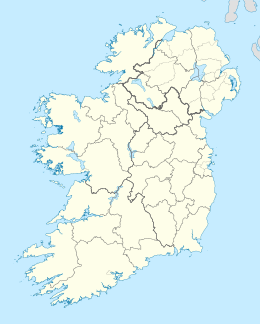Native name: Inis Caoil | |
|---|---|
 Building at the south east end of Inishkeel | |
| Geography | |
| Location | Atlantic Ocean |
| Coordinates | 54°50′51″N 8°27′22″W / 54.84750°N 8.45611°W |
| Area | 0.391 km2 (0.151 sq mi)[1] |
| Administration | |
| Province | Ulster |
| County | Donegal |
| Demographics | |
| Population | 0 (2011[2]) |
Inishkeel (Irish: Inis Caoil)[3] is a small tidal island and a townland[1] off the coast of County Donegal, Ireland. The closest village on the mainland is Narin.
Geography
[edit]The island is located in Gweebarra Bay around 250 m from the coast. A sandy tidal bank connects, with low tide, the island with the mainland.[3]
History
[edit]
During the 6th century A.D. a small community of monks settled on the island. Their religious leader was Saint Conall Cael, from whom the island later derived its name. During the following centuries Inishkeel was a traditional destination of pilgrimages. Remains of the church and the connected buildings as well as some carved stones can be seen on the island.[4] For its artistical and archeological importance the island was declared National Monument (code: DG064-003).[5] A bell known as St Conall Cael's Bell remained on Inishkeel up to the 19th century and was then acquired by the British Museum.[6]
Demography
[edit]A small community used to live on Inishkeel in the past, and in year 1841 23 inhabitants were registered on the island.[7] The island was later abandoned and in 2011 census had no inhabitants.[2]
References
[edit]
- ^ a b "Inishkeel Townland, Co. Donegal". www.townlands.ie. Cóipcheart Townlands.ie. Retrieved 9 May 2016.
- ^ a b Population (Number) by Off Shore Island, Year and Sex Central Statistics Office
- ^ a b Liam Ronayne (2000). Donegal: South of the Gap. Dundurn. ISBN 9781900935159. Retrieved 9 May 2016.
- ^ "Inishkeel Monastic Site". www.megalithicireland.com. Retrieved 9 May 2016.
- ^ National Monuments in State Care: Ownership & Guardianship (PDF). National Monuments Service / Seirbhís na Séadcomharthaí Náisiúnta. 2009. Retrieved 19 April 2021.
- ^ Rowena Loverance (2007). Christian Art. Harvard University Press. ISBN 9780674024793. Retrieved 9 May 2016.
- ^ Commissioners 4th Rpt, p.15 Newport West E Division
See also
[edit]![]() Media related to Inishkeel at Wikimedia Commons
Media related to Inishkeel at Wikimedia Commons


Well, that’s interesting to know that Psilotum nudum are known as whisk ferns. Psilotum nudum is the commoner species of the two. While the P. flaccidum is a rare species and is found in the tropical islands. Both the species are usually epiphytic in habit and grow upon tree ferns. These species may also be terrestrial and grow in humus or in the crevices of the rocks.
View the detailed Guide of Psilotum nudum: Detailed Study Of Psilotum Nudum (Whisk Fern), Classification, Anatomy, Reproduction